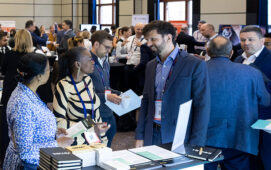As well as the data standardisation challenge, the Office of Financial Research (OFR) and the Financial Stability Oversight Council (FSOC) also face the “significant scientific task” of understanding how to use this data, according to academic John Liechty, professor of marketing and statistics at Smeal College of Business for Penn State University and director for the Centre for the Study of Global Financial Stability (see his CV and bio here). During last week’s government organised conference on financial stability and the OFR, Liechty, who was one of the lead champions for the precursor to the OFR, the National Institute of Finance (NIF), highlighted the true scale of the challenge ahead of the recently established bodies: “not only do we not have the data in place, we have not done the science needed to understand system-wide risks to the financial system.”
He compared the challenge of understanding the data (once it has been collected, that is) to the task of interpreting complex weather data when the US National Oceanic and Atmospheric Administration (NOAA) was first established. However, given the complex nature of many of the data items in question, including accounting data, internal risk reports, transaction and position data (as listed by Liechty), the challenge is likely to be even greater.
Much like Berner, Liechty is also convinced that the new data standards that will be established by the OFR’s efforts will prove useful to the industry in terms of improved risk management and “operational savings,” also thus ignoring the potential of the standards to become just another cross reference. He reckons the requirements will compel firms to get their back offices in order, rather than in resulting in tactical workarounds.
During his speech, he noted the “disarray” that most firms’ back offices are in with regards to capturing basic reference data items and the “time consuming” task of producing comprehensive risk reports as a result. He also indicated that he is aware of the need to avoid duplication in the reporting process, but suggested that: “With regards to detailed transaction and position data, the OFR will be collecting data that has never been collected in a systematic manner by regulators; hence these data collection efforts will not represent a dual reporting burden.” This statement perhaps belies the US-centric view within the OFR, given that transaction reporting has been happening under MiFID in Europe (albeit with mixed results) since it was implemented in 2007.
He also stressed the need for a consistent source of identifiers, which is at the heart of the OFR’s recent efforts in the legal entity identification space and beyond. To this end, he noted three main benefits that would stem from the adoption of these IDs and transaction reporting: “First, firms would have an electronic copy of all of their transactions reflected in their central IT systems, at the time that they are settled and they would be able to routinely produce risk reports that reflected all of their firm’s exposures. Second, it would be relatively straightforward for firms to provide an electronic cc to the OFR when transactions settle – allowing the OFR to build a comprehensive view of the financial system and then share this data with the members of the FSOC. Third, it would result in dramatic operational savings for the industry. The universal identifiers are needed in order to allow OFR to build a consistent counterparty network; they are also essential for helping market participants reduce order matching errors.”
These benefits, of course, are all dependent on firms ripping out and replacing their old legacy back office systems in order to accommodate the data in a central repository and the OFR having the ability to make use of the mountains of raw data it will accumulate…
From a high level regulatory perspective, Liechty stressed the importance of getting the systemic risk monitoring infrastructure in place to be able to prevent a future crisis. “If we can’t get this right and there is another crisis, then there is a very real risk that the political response may result in a response that adversely affects the financial market’s ability to innovate,” he warned.
In terms of systemic risk analysis and potential scientific approaches to this new field, Liechty discussed a range of “important elements” that must be incorporated in systemic risk models (all of which can be seen towards the end his testimony in the document below), including environmental and historical factors.
Moreover, he ended his speech last week with a call for the US government to nominate a director of the OFR ASAP: “Until that happens, the OFR will be limited in its ability to become established and help provide the insights that we need.”
Subscribe to our newsletter




